Garden centerpieces transform ordinary outdoor spaces into extraordinary retreats that captivate the senses and create lasting memories. These focal points serve as the heart of your landscape design, drawing the eye and establishing a strong visual foundation for your entire garden. Whether you prefer the soothing sounds of flowing water, the artistic elegance of sculptural elements, or the vibrant beauty of container gardens, the right centerpiece can define your outdoor space's character. Modern garden centerpieces combine functionality with aesthetic appeal, offering year-round interest while supporting wildlife and enhancing your property's value. From intimate courtyard features to grand landscape installations, these design ideas will help you create an outdoor sanctuary that reflects your personal style and serves as a natural gathering place for family and friends.
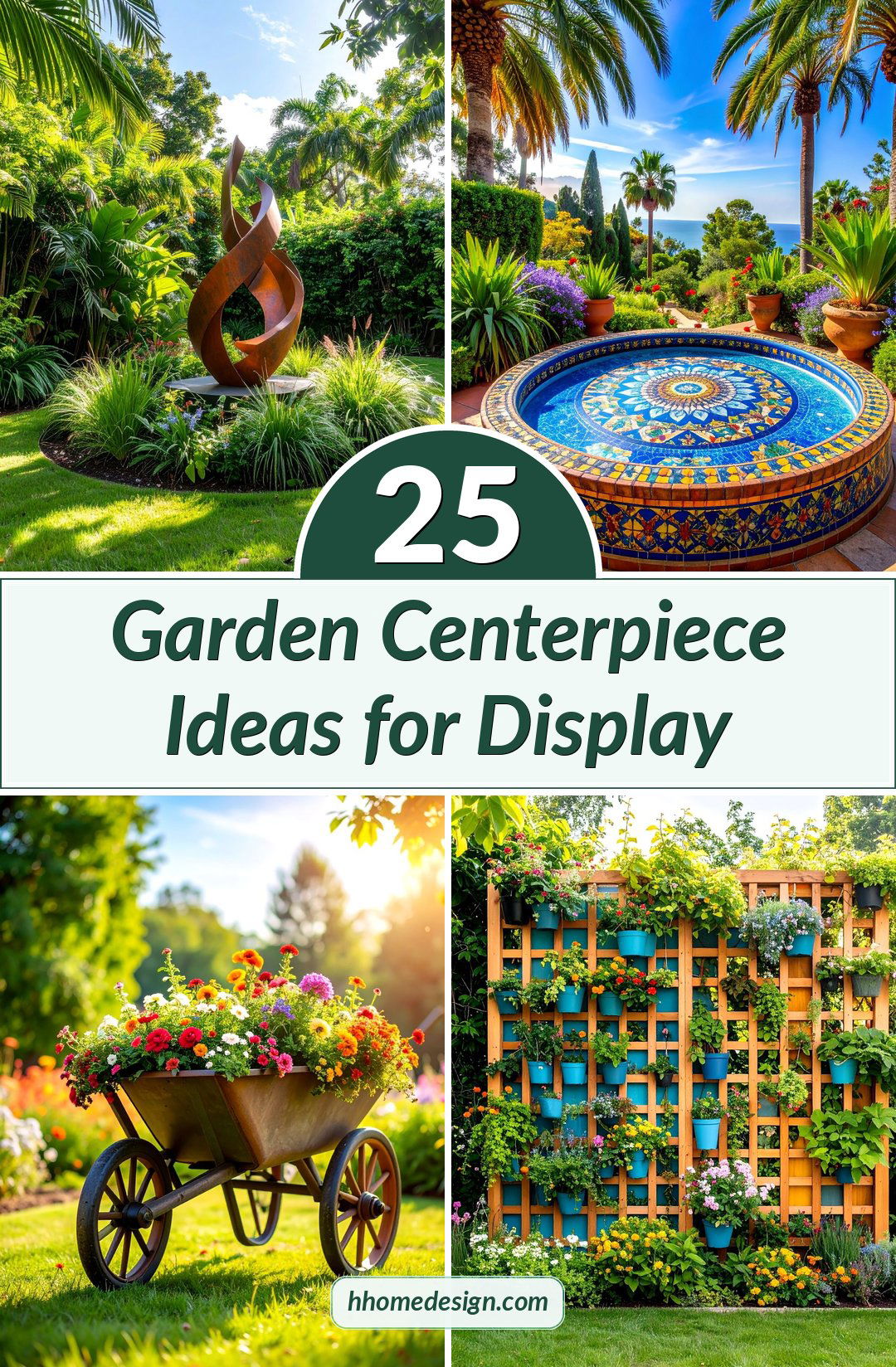
1. Tiered Stone Fountain with Surrounding Garden Beds
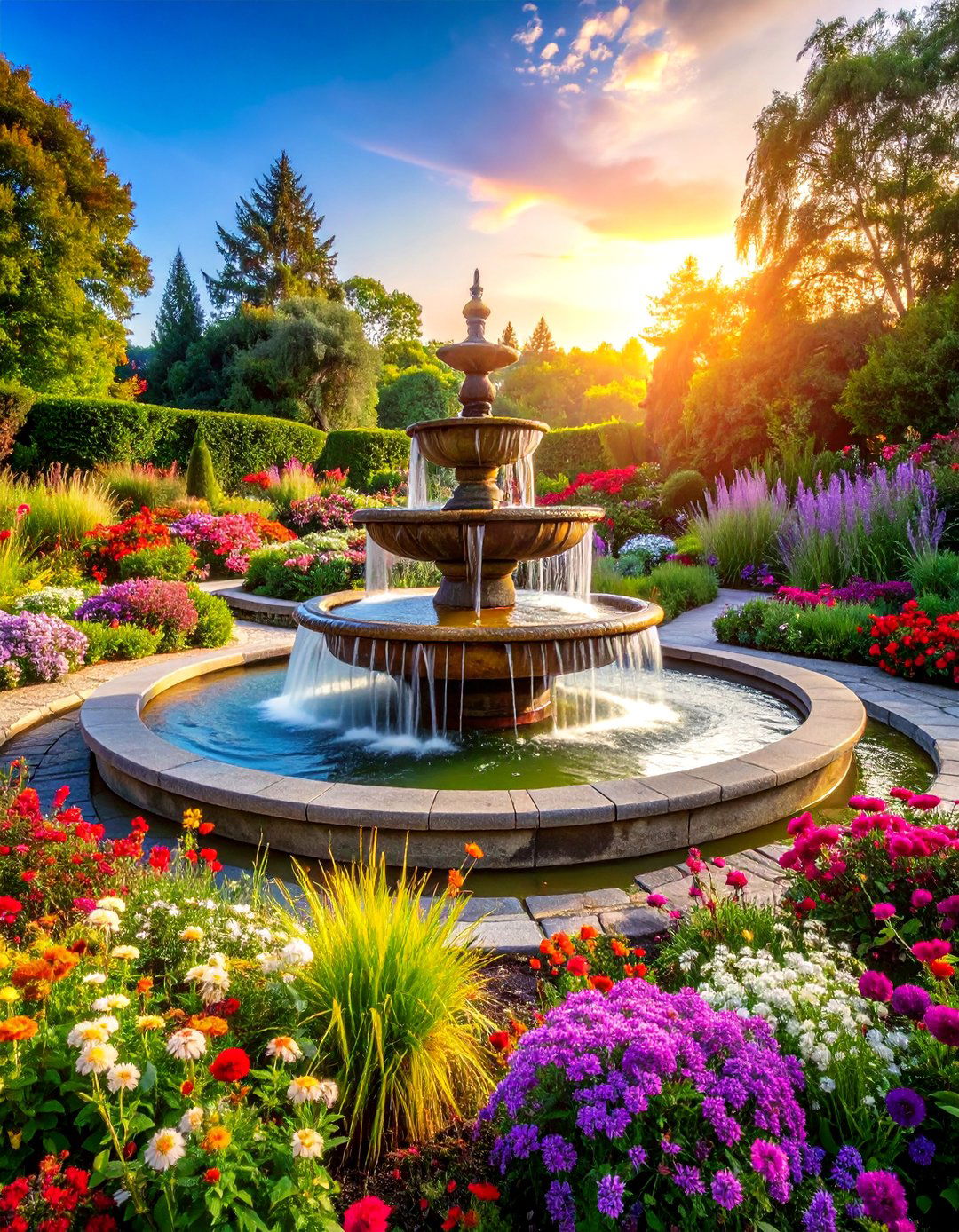
A tiered stone fountain creates an elegant focal point that combines the soothing sounds of cascading water with classical design elements. Position this centerpiece in the center of your garden with carefully planned planting beds radiating outward in a circular pattern. Choose natural stone materials like limestone or granite that complement your home's architecture, and surround the fountain with low-growing perennials such as lavender, ornamental grasses, and seasonal flowers. The gentle sound of water flowing between tiers creates a peaceful atmosphere while attracting birds and beneficial insects. Install subtle LED lighting around the base to highlight the fountain's architecture during evening hours, and consider adding a small recirculating pump system for energy efficiency and consistent water flow throughout the seasons.
2. Abstract Metal Sculpture Garden with Modern Plantings

Create a contemporary garden centerpiece using a large abstract metal sculpture as the anchor point, surrounded by architectural plantings that emphasize clean lines and geometric forms. Select weather-resistant materials like corten steel or stainless steel that develop beautiful patina over time or maintain their polished finish. Design the surrounding landscape with ornamental grasses, sculptural agaves, and plants with strong architectural forms like yuccas or large hostas. Use gravel or decomposed granite pathways to create defined viewing areas around the sculpture, and incorporate bench seating at strategic angles for contemplation. The interplay between the artistic metalwork and living plants creates a sophisticated outdoor gallery that changes with the seasons while maintaining its modern aesthetic year-round.
3. Vertical Tower Container Garden with Seasonal Displays
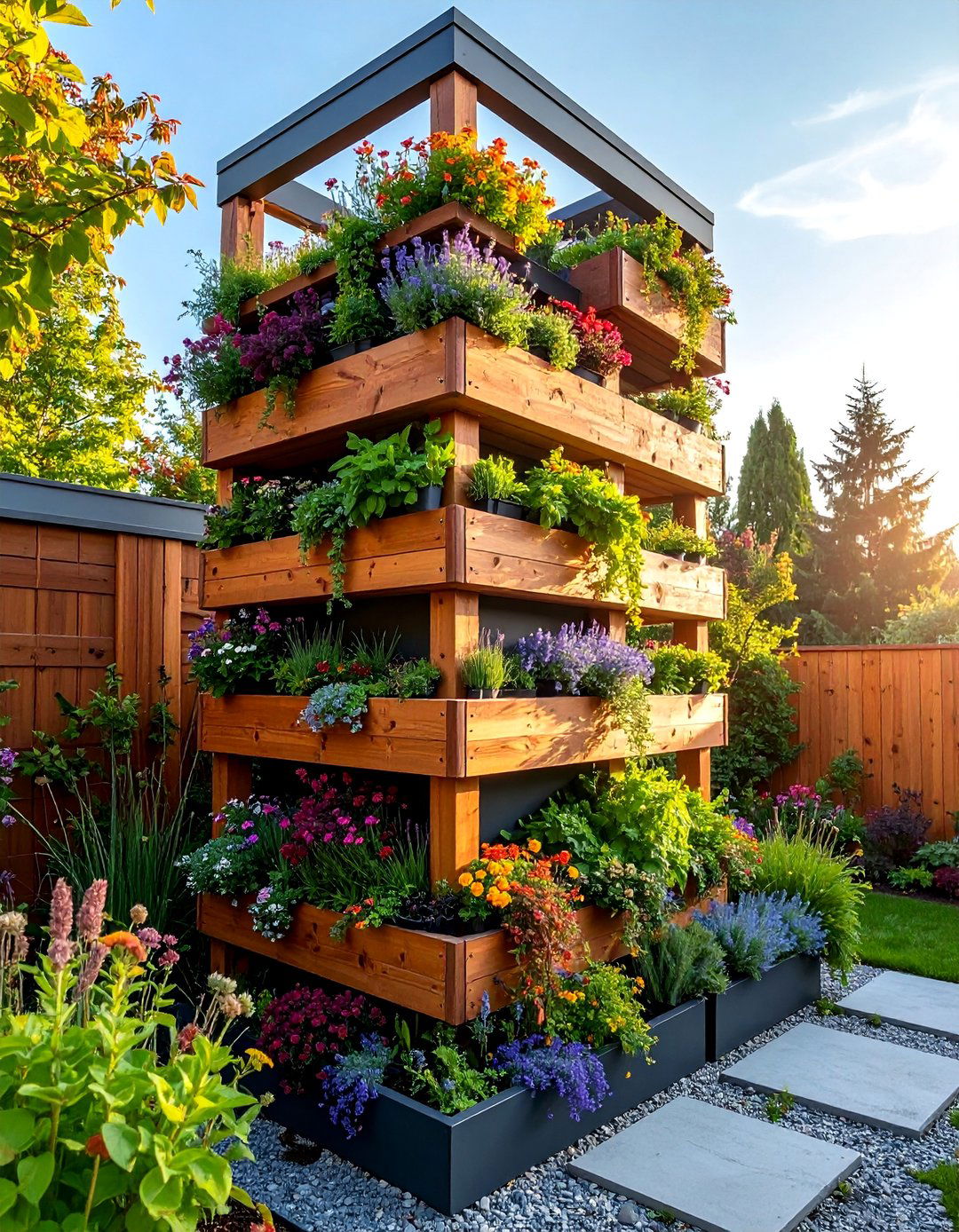
Construct a dramatic vertical tower centerpiece using stacked planters or modular container systems that create height and visual impact in compact spaces. Build the tower using materials like cedar, metal, or composite decking, incorporating multiple planting levels that allow for diverse plant combinations and seasonal rotation. Plant each level with complementary species that provide cascading, upright, and trailing elements, such as petunias, herbs, succulents, and ornamental grasses. Include an integrated irrigation system with drip lines to ensure consistent watering throughout the structure. Position the tower where it can be viewed from multiple angles, and surround the base with seasonal annuals and perennials that echo the tower's color scheme and create a cohesive garden vignette.
4. Fire Pit Seating Circle with Surrounding Landscape
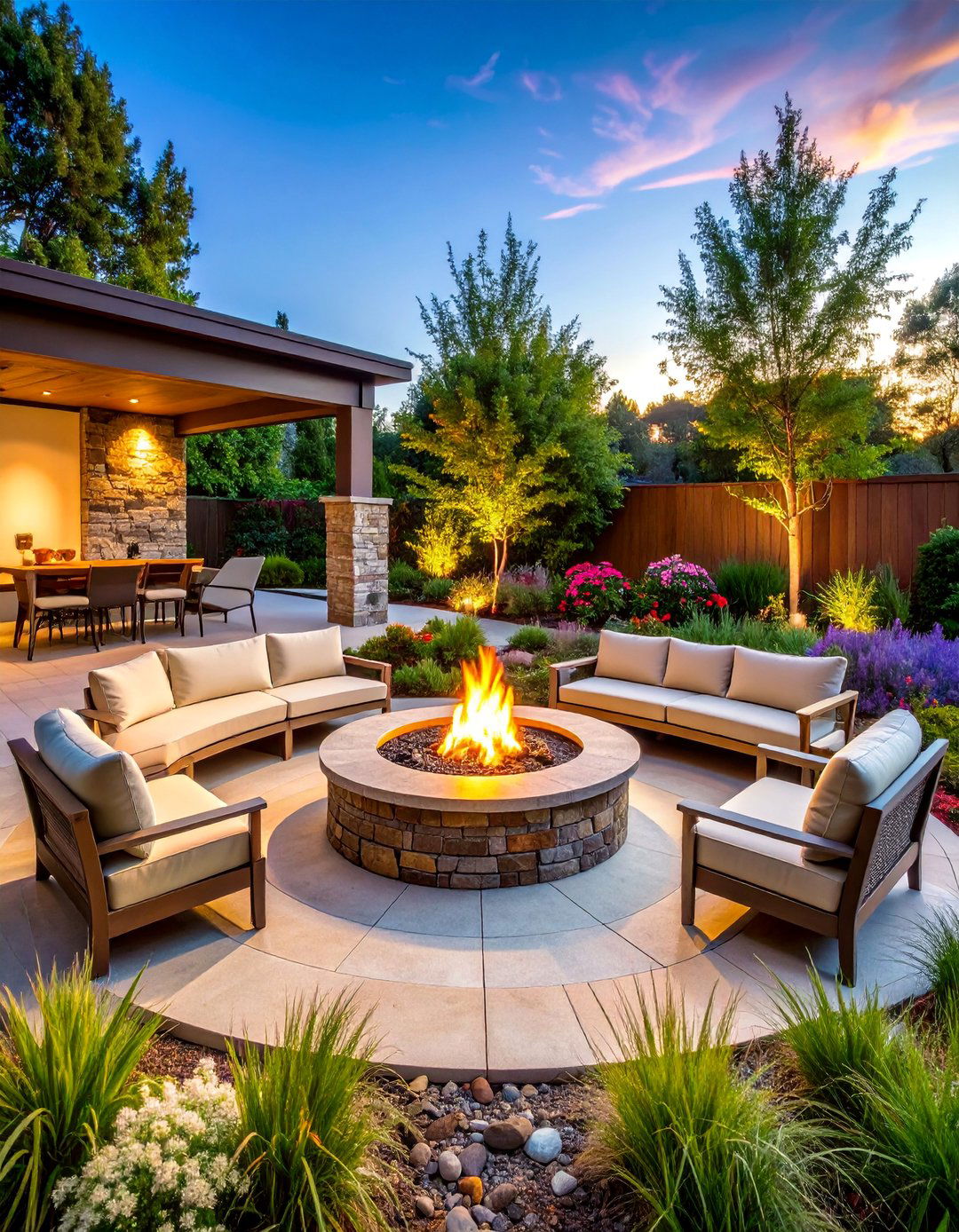
Design a fire pit centerpiece that serves as both a functional gathering space and a striking landscape feature throughout all seasons. Create a circular seating area using natural stone or concrete, with built-in benches or moveable seating options that accommodate various group sizes. Surround the fire pit with heat-tolerant plants like ornamental grasses, sedums, and drought-resistant perennials that can withstand the occasional spark and radiant heat. Install proper drainage and follow local fire safety regulations, including maintaining adequate clearance from structures and overhanging branches. Enhance the evening ambiance with low-voltage pathway lighting that leads to the seating area, and consider incorporating storage solutions for firewood and fire-starting materials that blend seamlessly with the landscape design.
5. Pondless Waterfall with Rock Garden Integration
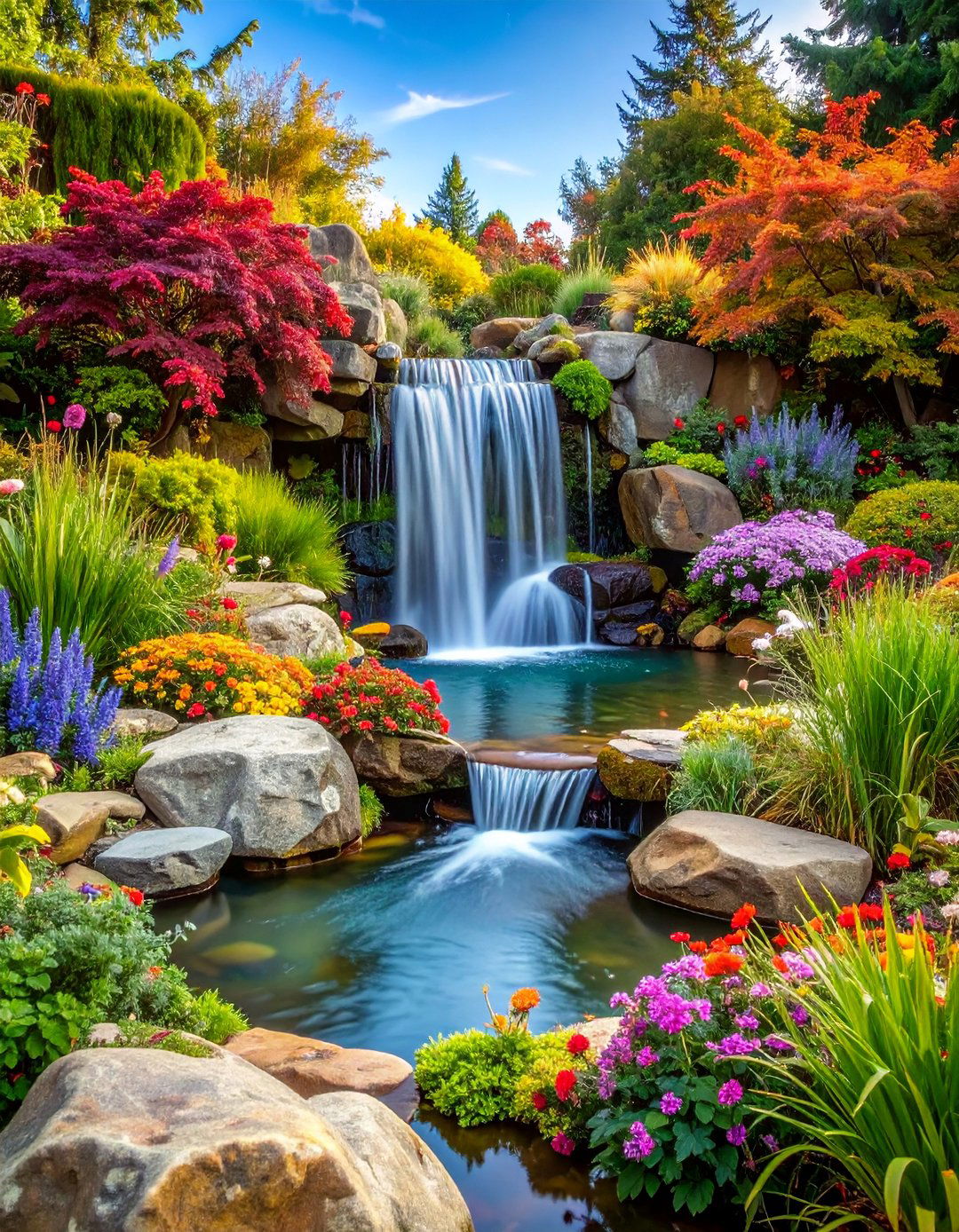
Build a pondless waterfall system that provides the beauty and sound of moving water without the maintenance requirements of a traditional pond. Construct the feature using natural stone and boulders arranged to create multiple cascading levels, with water disappearing into a hidden reservoir system. Integrate drought-tolerant rock garden plants like sedums, alpine plants, and small ornamental grasses between the stones to create a naturalistic mountain stream appearance. Install energy-efficient pumps and LED lighting to highlight the water movement during evening hours. The pondless design eliminates safety concerns while providing habitat for birds and creating negative ions that improve air quality. Position viewing areas at different elevations to appreciate the feature from various perspectives.
6. Gazebo Centerpiece with Climbing Plant Framework
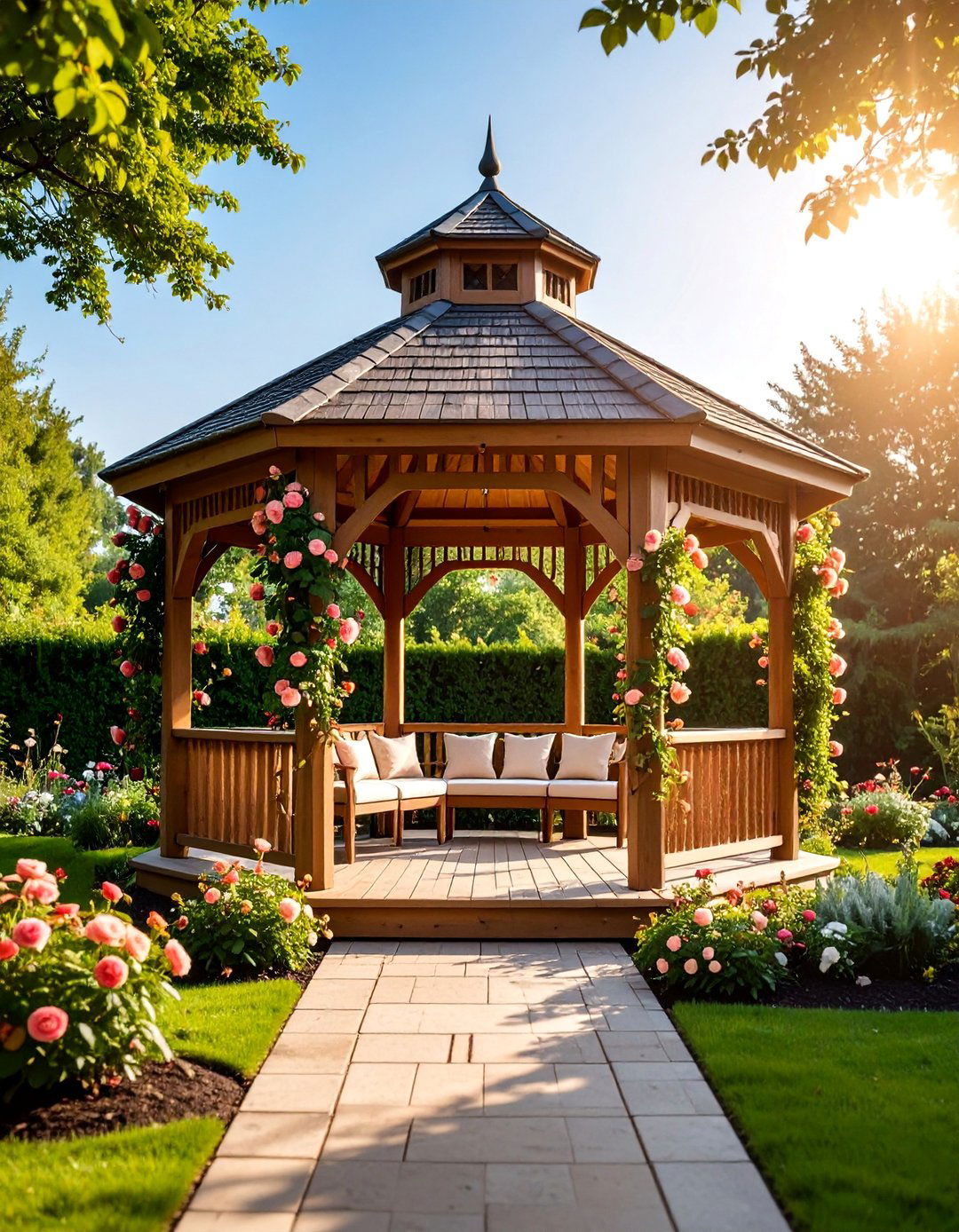
Install a gazebo structure that serves as both an architectural focal point and a living framework for climbing plants and seasonal displays. Choose materials that complement your home's style, whether traditional wood, elegant wrought iron, or modern aluminum with clean lines. Train climbing roses, clematis, or seasonal vines up the support posts and across overhead beams to create natural shade and privacy. Furnish the interior with weather-resistant seating and perhaps a small side table for outdoor dining or relaxation. Surround the gazebo base with foundation plantings that provide year-round structure and seasonal color, using a mix of evergreen shrubs and flowering perennials. Install hanging baskets or planter boxes from the gazebo's frame to add vertical gardening elements and create additional visual interest.
7. Modern Water Bowl with Minimalist Surrounding Design

Create a zen-like centerpiece using a large, shallow water bowl made from materials like concrete, natural stone, or weathered metal as the focal point of a minimalist garden design. Position the bowl at ground level or slightly elevated on a simple platform, surrounded by carefully raked gravel or smooth river stones that extend outward in geometric patterns. Plant the surrounding area with structural plants like ornamental grasses, bamboo, or carefully pruned shrubs that maintain clean lines and simple forms. Add floating water plants like water lilies or lotus for natural beauty and to help maintain water quality. Include a small bubbler or fountain feature within the bowl to create gentle water movement and prevent stagnation while maintaining the serene, minimalist aesthetic.
8. Herb Spiral Planter with Culinary Garden Theme
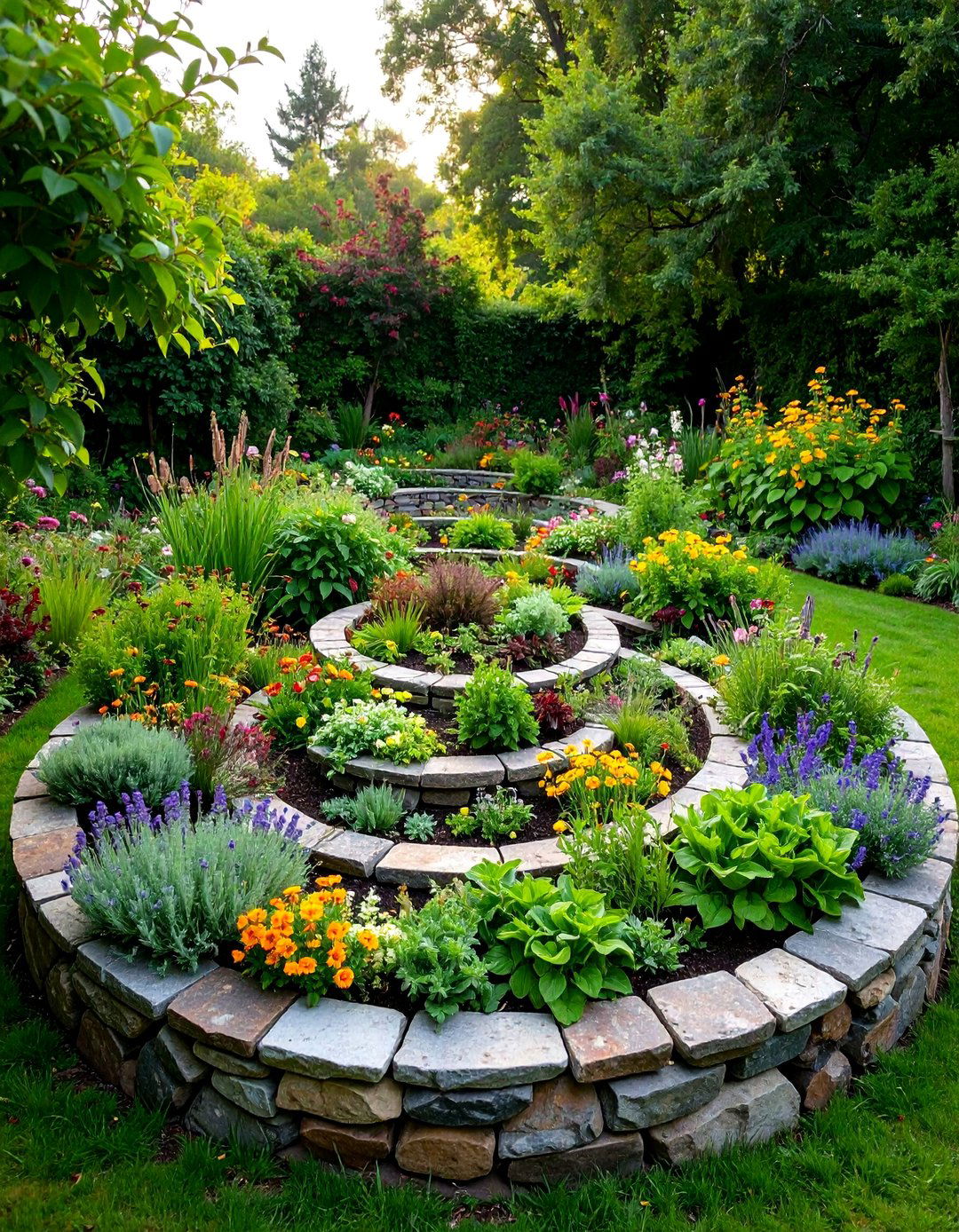
Construct a spiral-shaped raised planter that creates an impressive centerpiece while providing practical growing space for culinary herbs and edible plants. Build the spiral using stone, brick, or composite materials, creating different microclimates from the top (driest) to the bottom (most moist) of the structure. Plant Mediterranean herbs like rosemary, thyme, and oregano at the top, transitioning to moisture-loving herbs like mint and parsley at the base. Include edible flowers, small vegetables, and fruit plants throughout the spiral to create a productive and beautiful focal point. Add stepping stones or a small pathway that winds around the spiral for easy harvesting access. Incorporate decorative elements like plant markers, small sculptures, or coordinating containers to enhance the culinary garden theme.
9. Classical Stone Statue with Formal Garden Layout

Install a classical stone statue or sculpture as the centerpiece of a formal garden design that emphasizes symmetry, balance, and traditional landscaping principles. Choose a statue that reflects your garden's style, whether classical Greek or Roman figures, modern interpretations, or abstract forms that create visual interest. Design symmetrical planting beds radiating from the statue's base, using boxwood hedges, topiary forms, or carefully maintained perennial borders. Create formal pathways using materials like brick, stone, or gravel that lead to and from the statue location. Include seasonal planting areas that can be refreshed throughout the year with annuals, bulbs, and seasonal decorations. Position bench seating at appropriate distances to create contemplation areas and viewing points that appreciate the statue's artistic qualities.
10. Solar-Powered Garden Light Installation with Evening Drama

Design a solar-powered lighting centerpiece that transforms your garden into a magical evening landscape while promoting sustainable energy use. Install a combination of stake lights, string lights, and accent fixtures that highlight key plants, pathways, and architectural features throughout the garden space. Create a central lighting feature using solar-powered lanterns, illuminated planters, or decorative light sculptures that serve as the main focal point after dark. Program the lighting system to create different moods and intensities throughout the evening hours, from subtle pathway guidance to dramatic uplighting effects. Surround the lighting installation with plants that look particularly striking when illuminated, such as ornamental grasses, plants with interesting bark textures, or flowers that open in the evening. Include comfortable seating areas positioned to appreciate the lighting effects.
11. Vintage Wheelbarrow Garden with Cottage Style Plantings

Transform a vintage or decorative wheelbarrow into a charming mobile garden centerpiece that embodies cottage garden style and rustic appeal. Fill the wheelbarrow with high-quality potting soil and plant it with a mix of cottage garden favorites like petunias, marigolds, sweet alyssum, and trailing ivy or bacopa. Position the wheelbarrow in a location where it can be easily viewed and accessed, and consider moving it seasonally to refresh your garden's appearance. Surround the wheelbarrow with complementary plantings that echo the cottage garden theme, including perennials like delphinium, hollyhocks, and climbing roses. Add rustic accessories like watering cans, garden tools, or vintage-style plant markers to enhance the nostalgic atmosphere. Ensure proper drainage by drilling holes in the wheelbarrow's bottom and adding gravel layers beneath the soil.
12. Kinetic Wind Sculpture with Dynamic Movement Elements

Install a kinetic wind sculpture that provides constantly changing visual interest as it responds to natural air currents and seasonal weather patterns. Choose from materials like stainless steel, copper, or powder-coated aluminum that will withstand outdoor conditions while maintaining their appearance over time. Position the sculpture where it will catch prevailing winds and can be viewed from multiple angles throughout your garden and from indoor windows. Design the surrounding landscape to complement the sculpture's movement, using plants that also respond to wind like ornamental grasses, bamboo, or plants with interesting seed heads. Create clear sightlines and open spaces around the sculpture to emphasize its kinetic qualities and prevent interference from nearby vegetation. Include seating areas positioned to appreciate the sculpture's changing configurations throughout different times of day and seasons.
13. Succulent Centerpiece Arrangement with Desert Garden Theme

Create a striking centerpiece using a large container or raised bed filled with diverse succulent varieties that provide year-round interest and low-maintenance beauty. Select a substantial container made from materials like concrete, ceramic, or natural stone that complements your garden's style and provides excellent drainage for succulent plants. Arrange different succulent species by height, texture, and color to create visual layers and seasonal interest, including varieties like echeveria, agave, sedums, and architectural cacti. Surround the container with drought-tolerant landscape plants and decorative gravel or stone mulch that reinforces the desert garden aesthetic. Include accent elements like driftwood, interesting rocks, or small sculptures that complement the succulent arrangement. Position the centerpiece where it receives appropriate sunlight for the selected plant varieties while creating a focal point visible from key garden areas.
14. Garden Arbor with Climbing Rose Integration and Seating Area

Construct a garden arbor that serves as both an architectural focal point and a living framework for climbing roses and other flowering vines. Build the arbor using materials like cedar, wrought iron, or composite materials that will support the weight of mature climbing plants while maintaining structural integrity. Plant climbing roses on either side of the arbor, selecting varieties that provide extended blooming periods and complement your garden's color scheme. Include a bench or seating area within or adjacent to the arbor to create a romantic retreat surrounded by fragrant blooms. Design pathways leading to and through the arbor using materials that complement the structure's style and connect to other garden areas. Add supporting elements like coordinating planters, garden lighting, or decorative hardware that enhance the arbor's visual appeal throughout all seasons.
15. Modern Concrete Planter Complex with Architectural Plants

Design a contemporary centerpiece using multiple concrete planters of varying sizes and heights arranged to create geometric interest and architectural drama. Cast or purchase planters in complementary shapes like rectangles, squares, and cylinders, positioning them at different elevations to create visual layers and dynamic composition. Plant each container with architectural specimens like ornamental grasses, large hostas, or sculptural plants that emphasize form and texture over seasonal color. Use a consistent color palette and plant selection throughout the planter complex to create cohesion while allowing each container to contribute to the overall design. Incorporate integrated lighting systems within or around the planters to highlight the architectural qualities during evening hours. Position the planter complex where it can anchor a larger garden area while providing viewing opportunities from multiple angles.
16. Mosaic Art Installation with Mediterranean Garden Surroundings
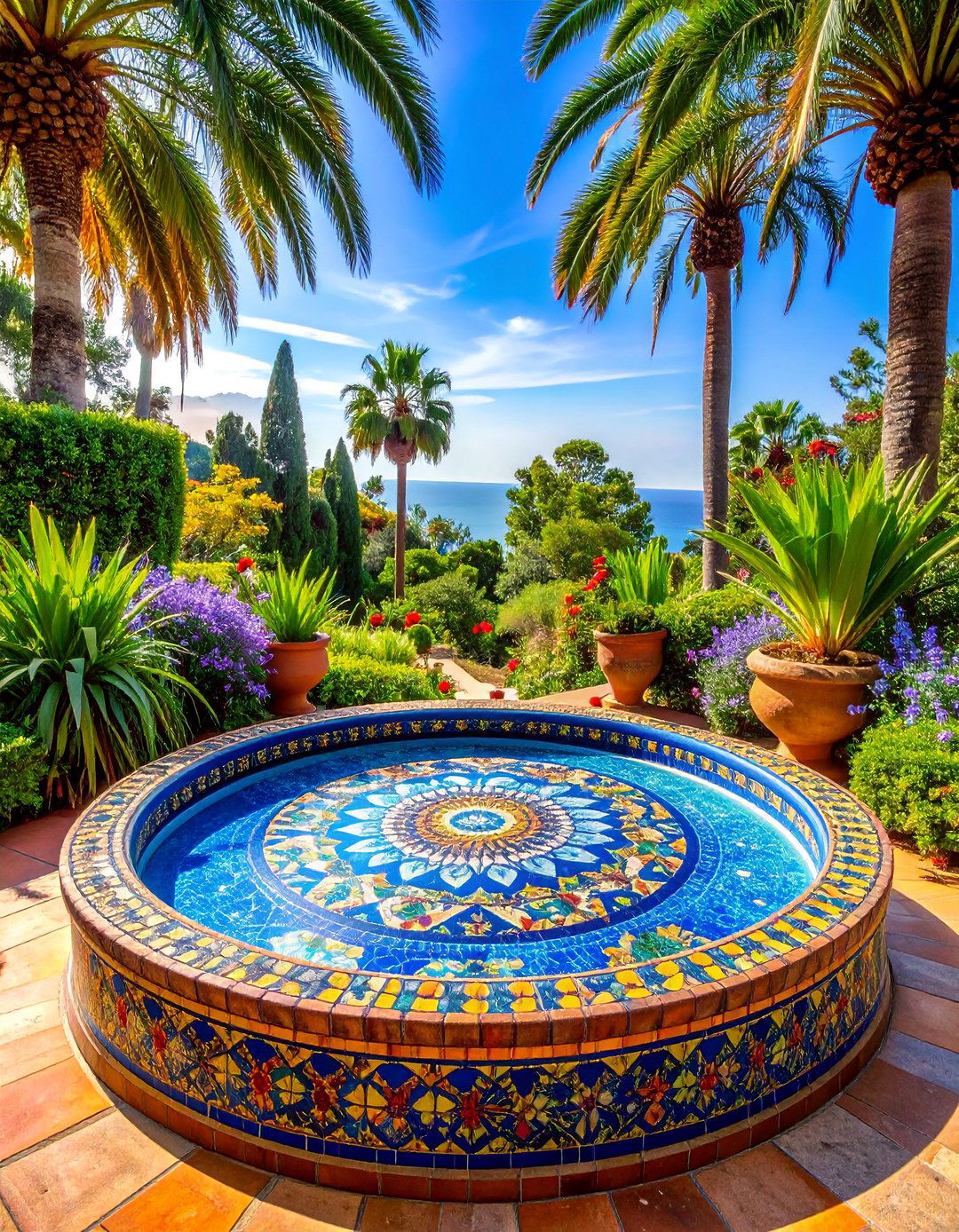
Create a stunning mosaic art installation as your garden's centerpiece, incorporating colorful tiles, glass, or stone arranged in patterns that reflect your personal style and garden theme. Design the mosaic as a wall feature, stepping stone pathway, or standalone sculpture that becomes a permanent artwork within your landscape. Surround the mosaic installation with Mediterranean-style plantings like lavender, rosemary, olive trees, and ornamental grasses that complement the artistic elements' colors and textures. Include seating areas positioned to appreciate the artwork's details and craftsmanship while enjoying the surrounding garden. Protect the mosaic from harsh weather conditions using appropriate sealers and materials designed for outdoor applications. Incorporate accent lighting that highlights the mosaic's colors and patterns during evening hours, creating a dramatic focal point that changes character throughout the day.
17. Terraced Container Garden with Multi-Level Planting Design

Build a terraced container garden centerpiece that creates multiple planting levels and provides opportunities for diverse plant combinations within a compact space. Construct the terracing using retaining materials like stone, timber, or concrete blocks, creating different elevation levels that accommodate various container sizes and plant requirements. Arrange containers of different sizes and materials throughout the terraced levels, allowing for seasonal changes and plant rotation throughout the growing year. Plant each level with complementary species that create visual flow between elevations while providing different bloom times and foliage interest. Include an integrated irrigation system that can efficiently water all levels of the terraced design. Position pathways or stepping areas that allow easy access for maintenance and plant care while creating viewing opportunities that appreciate the multi-dimensional design.
18. String Light Canopy with Outdoor Dining Integration

Install a string light canopy centerpiece that creates magical evening ambiance while defining an outdoor dining and entertainment area within your garden space. Suspend weather-resistant string lights between posts, trees, or architectural structures to create an overhead canopy that provides gentle illumination and spatial definition. Choose lighting options like Edison bulbs, globe lights, or LED strips that complement your garden's style and provide appropriate light levels for dining and socializing. Position dining furniture or conversation areas beneath the light canopy, surrounded by plantings that create privacy and enhance the intimate atmosphere. Include dimmer controls or timer systems that allow for different lighting levels throughout the evening hours. Design the surrounding landscape with fragrant plants like jasmine, gardenias, or herbs that enhance the sensory experience of evening garden use.
19. Natural Stone Cairn with Zen Garden Elements
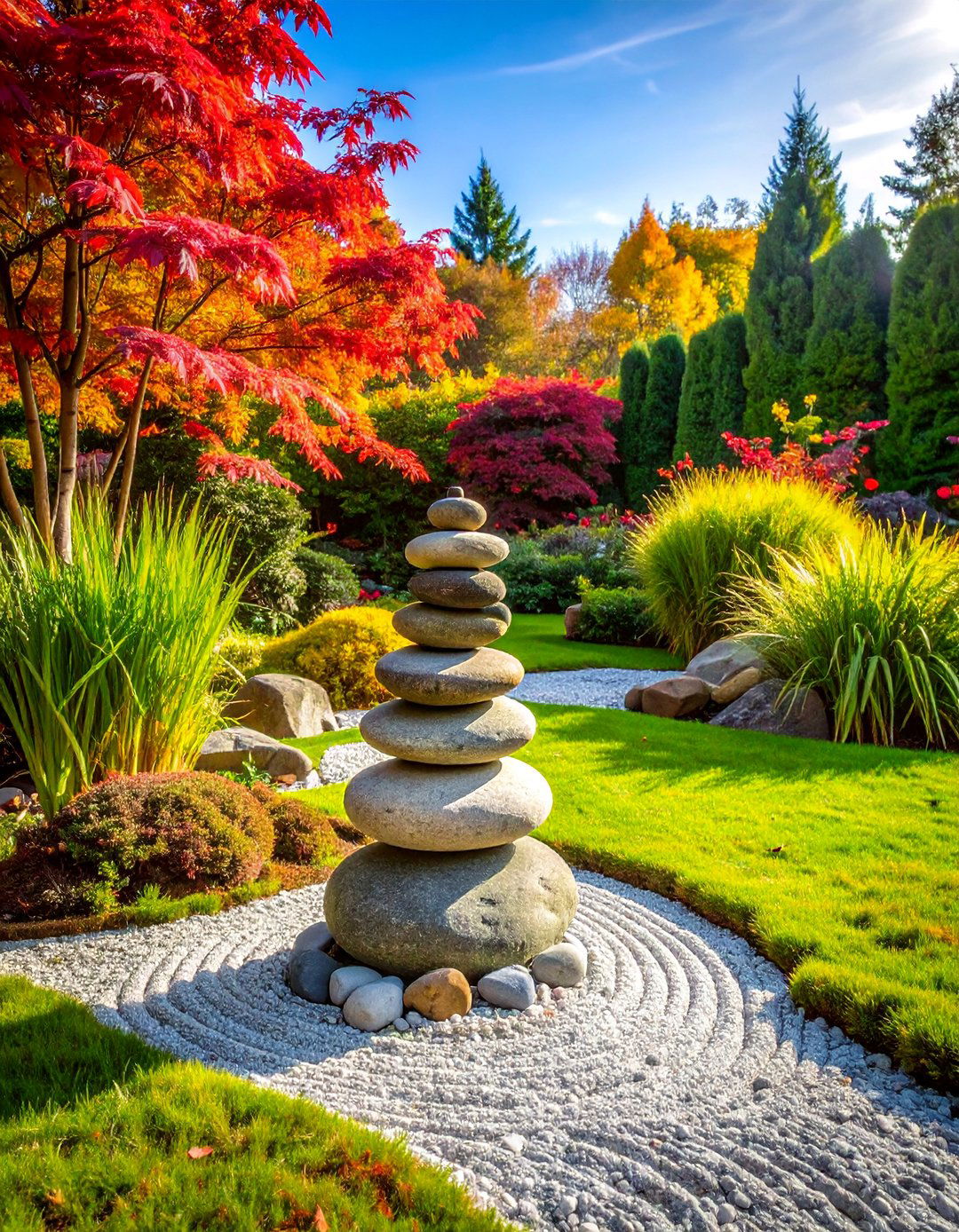
Construct a natural stone cairn centerpiece that provides meditative focal point while incorporating zen garden principles of simplicity, balance, and natural materials. Select stones of varying sizes and textures, carefully balancing them to create a sculptural tower that appears both natural and intentional. Surround the cairn with carefully raked gravel, sand, or small stones arranged in patterns that create visual calm and encourage contemplation. Include minimal plantings like ornamental grasses, small bamboo, or carefully pruned shrubs that complement the zen aesthetic without overwhelming the stone feature's simplicity. Create pathways or seating areas that allow for quiet contemplation and meditation while appreciating the cairn's natural beauty. Position the feature where it can be viewed from indoor spaces as well as garden areas, providing year-round visual interest and spiritual focus.
20. Trellis Wall Garden with Vertical Growing System
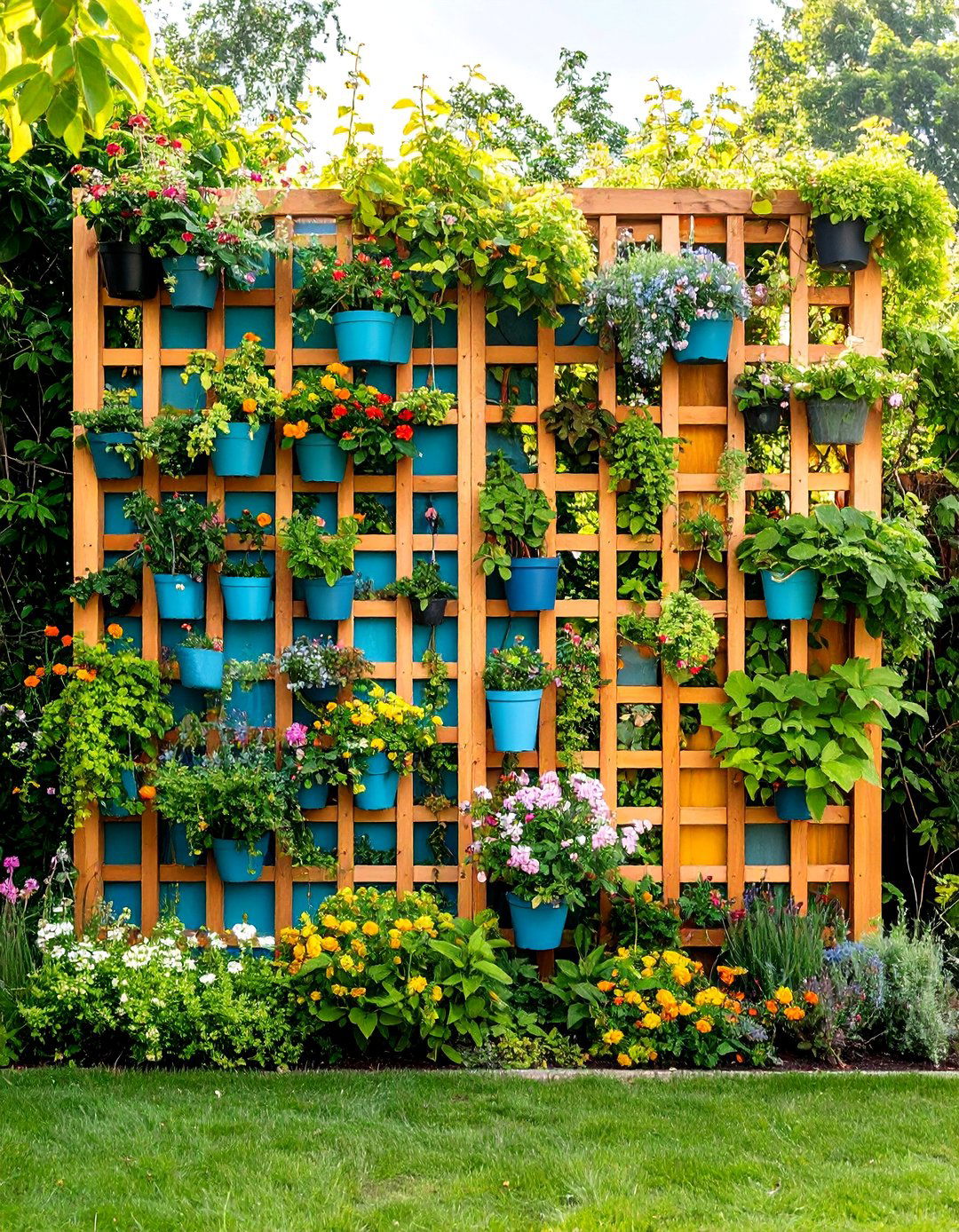
Build a substantial trellis wall that serves as both a garden centerpiece and a vertical growing system for climbing plants, hanging containers, and seasonal displays. Construct the trellis using materials like cedar, metal, or composite materials that provide strong support for mature plants while maintaining visual appeal throughout all seasons. Train climbing vines like clematis, morning glories, or passion vines up the trellis structure, creating a living wall that changes with the seasons. Incorporate hanging baskets, window boxes, or wall-mounted planters at various heights throughout the trellis system to add color and texture variety. Include integrated irrigation systems that efficiently water all planting levels without creating water damage to the trellis structure. Position the wall where it can provide privacy screening while creating a dramatic backdrop for other garden areas.
21. Rain Garden Collection System with Native Plant Integration

Design a rain garden centerpiece that collects and filters stormwater runoff while providing habitat for native plants and wildlife throughout the growing season. Create a shallow depression or basin that captures rainwater from roofs, driveways, or other hard surfaces, allowing it to slowly infiltrate into the soil. Plant the rain garden with native species that tolerate both wet and dry conditions, such as native wildflowers, grasses, and shrubs that provide seasonal interest. Include decorative stone or gravel elements that help direct water flow and prevent erosion during heavy rainfall events. Design pathways or viewing areas that allow appreciation of the rain garden's ecological function and natural beauty. Position the feature where it can address actual drainage issues while creating an attractive and environmentally beneficial garden centerpiece.
22. Outdoor Kitchen Garden with Edible Centerpiece Design
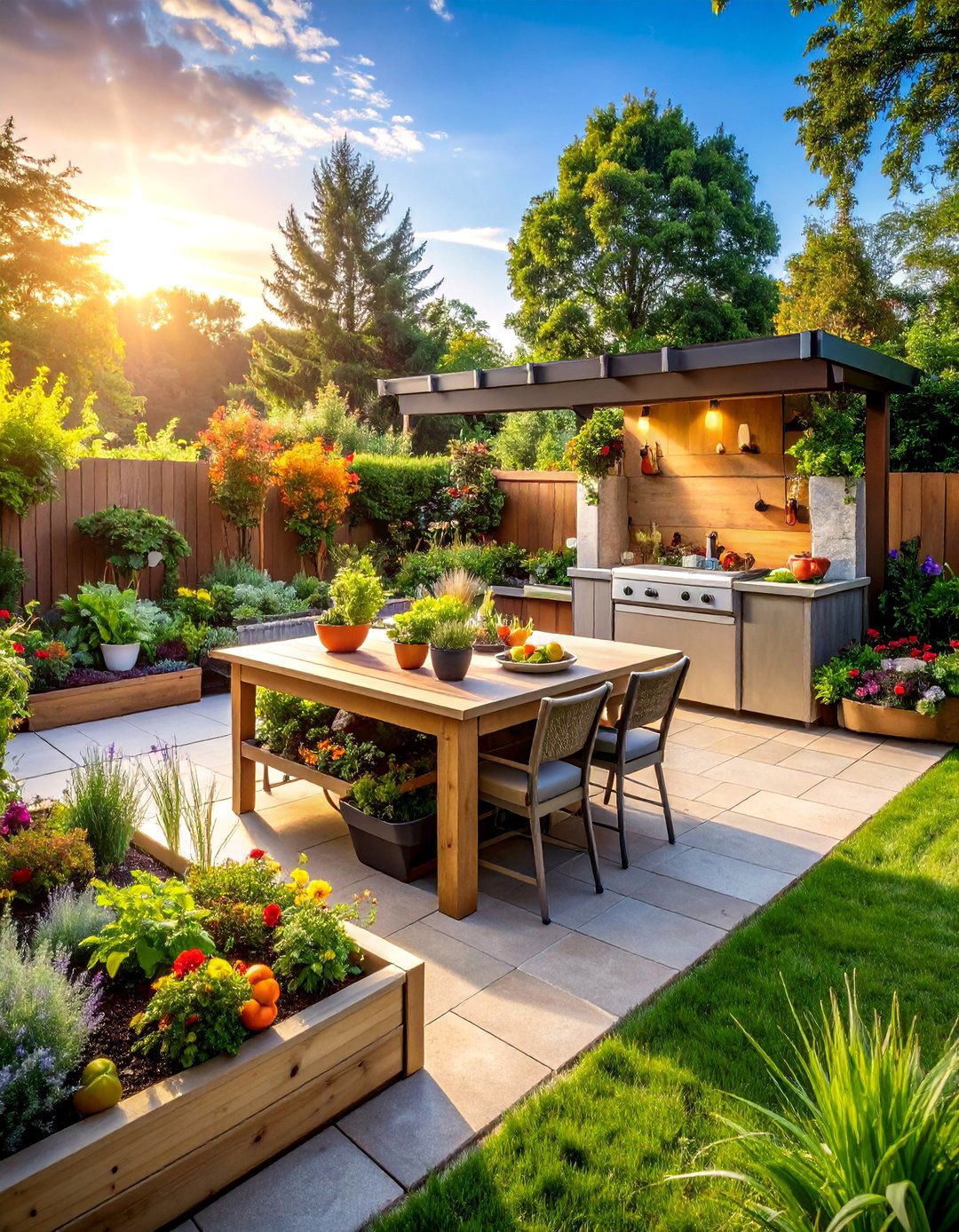
Create an outdoor kitchen garden centerpiece that combines raised beds, container plantings, and workspace areas for growing, harvesting, and preparing fresh garden produce. Design the layout to include multiple growing areas for vegetables, herbs, and edible flowers arranged around a central preparation or workspace area. Include materials like stone, brick, or composite decking for pathways and work surfaces that withstand weather and heavy use throughout the growing season. Plant the beds with a rotation of seasonal vegetables, perennial herbs, and edible landscaping plants that provide both harvest potential and ornamental value. Incorporate storage solutions for tools, supplies, and harvest containers that blend seamlessly with the garden's aesthetic design. Position the kitchen garden near outdoor cooking areas or within easy access of indoor kitchen spaces for maximum functionality and convenience.
23. Pergola Structure with Hanging Garden Elements
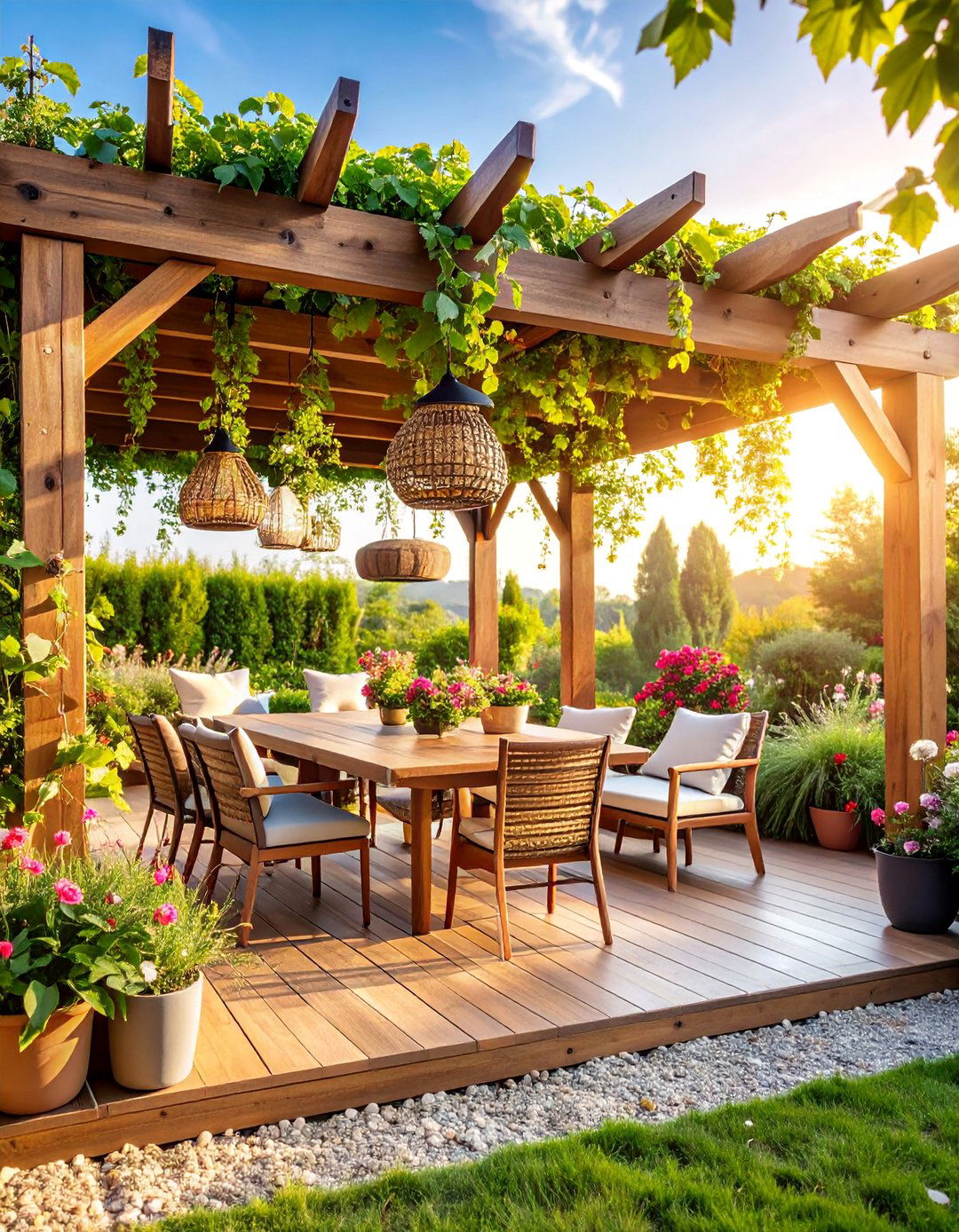
Install a pergola centerpiece that provides architectural framework for hanging gardens, climbing plants, and overhead growing systems throughout your outdoor space. Build the pergola using materials that complement your home's architecture while providing strong support for mature climbing plants and hanging containers. Train grapevines, wisteria, or other vigorous climbers across the overhead beams to create natural shade and seasonal interest above the structure. Hang baskets, planters, or growing systems from the pergola's framework at varying heights to create vertical gardening opportunities and visual layers. Include comfortable seating or dining areas beneath the pergola that take advantage of the natural shade and overhead garden display. Design the surrounding landscape to complement the pergola's scale and style while creating smooth transitions to other garden areas.
24. Moon Gate Entrance with Circular Garden Design

Construct a moon gate entrance feature that creates a dramatic circular opening and serves as a transition between different garden areas or outdoor spaces. Build the circular structure using materials like stone, brick, or metal that complement your garden's overall design while providing long-term durability and visual impact. Design circular or curved planting beds that echo the moon gate's shape, using plants with rounded forms, flowing habits, or circular growth patterns. Include climbing vines or training plants around the moon gate's frame to soften the architectural lines and integrate the structure with surrounding vegetation. Create pathways that lead to and through the moon gate, enhancing the sense of journey and discovery within your garden design. Position the moon gate where it frames attractive views or creates anticipation for garden areas beyond the entrance.
25. Living Tree Centerpiece with Surrounding Seasonal Garden

Select and position a specimen tree as your garden's living centerpiece, choosing species that provide multiple seasons of interest through flowers, foliage, bark, and overall form. Consider options like Japanese maples, flowering cherries, magnolias, or evergreen specimens that create strong focal points while supporting garden ecosystem health. Design seasonal planting beds around the tree's base that complement the tree's characteristics while providing changing color and texture throughout the year. Include spring bulbs, summer perennials, fall-blooming plants, and winter-interest elements that create year-round garden appeal beneath the tree's canopy. Install subtle lighting that highlights the tree's structure and surrounding plantings during evening hours without disturbing the natural ecosystem. Create seating or viewing areas positioned to appreciate the tree's growth and seasonal changes while enjoying the surrounding garden's evolution.
Conclusion:
Creating the perfect garden centerpiece transforms your outdoor space into a personal sanctuary that reflects your style and enhances your quality of life. Whether you choose water features for tranquility, sculptural elements for artistic appeal, or living installations for natural beauty, the key lies in selecting designs that complement your landscape and lifestyle needs. These centerpiece ideas provide frameworks for developing unique outdoor spaces that evolve with the seasons while maintaining year-round visual interest. Remember to consider maintenance requirements, local climate conditions, and your garden's existing features when selecting your centerpiece design. With thoughtful planning and creative implementation, your chosen centerpiece will become the heart of your garden, creating lasting memories and increasing your property's beauty and value for years to come.



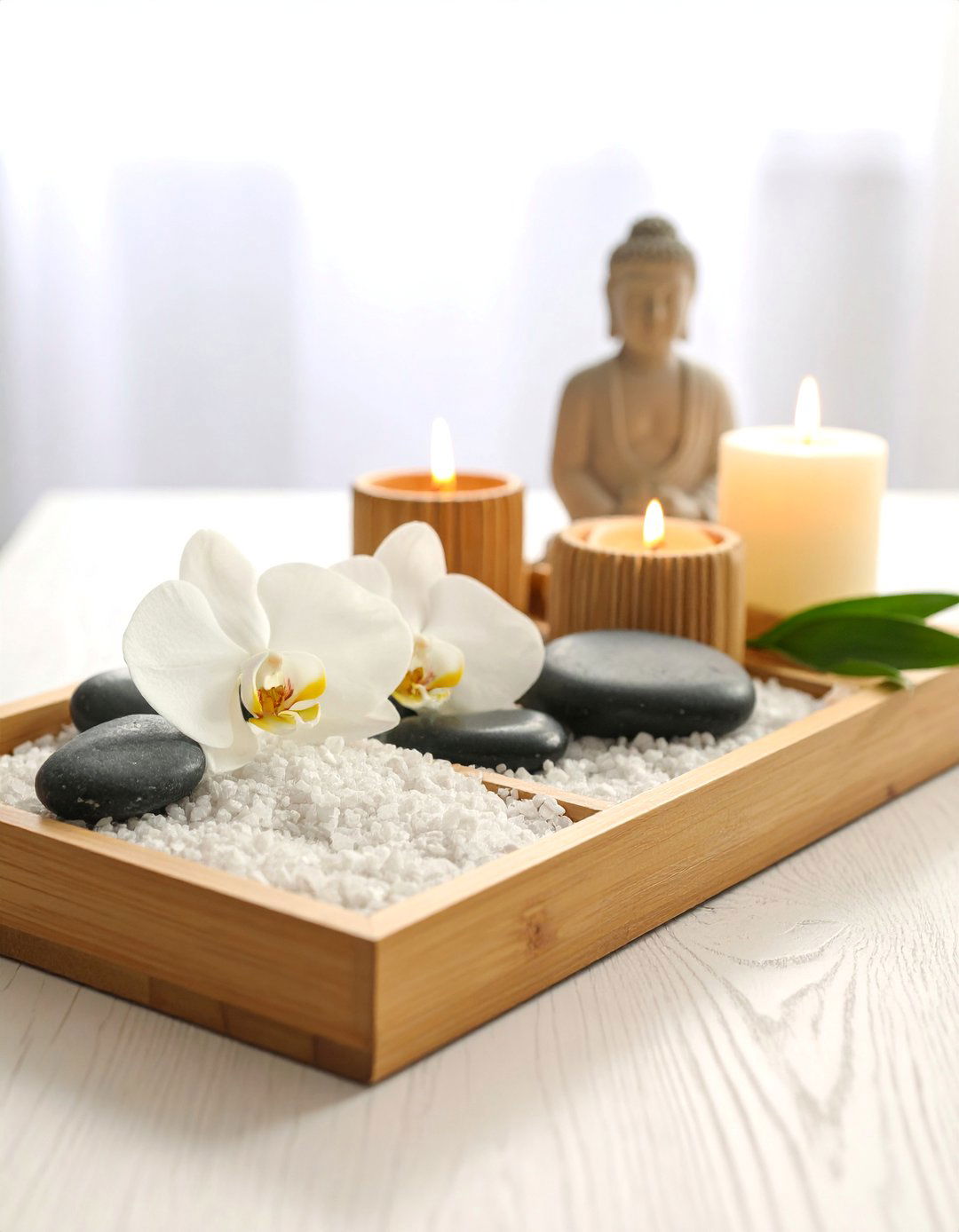
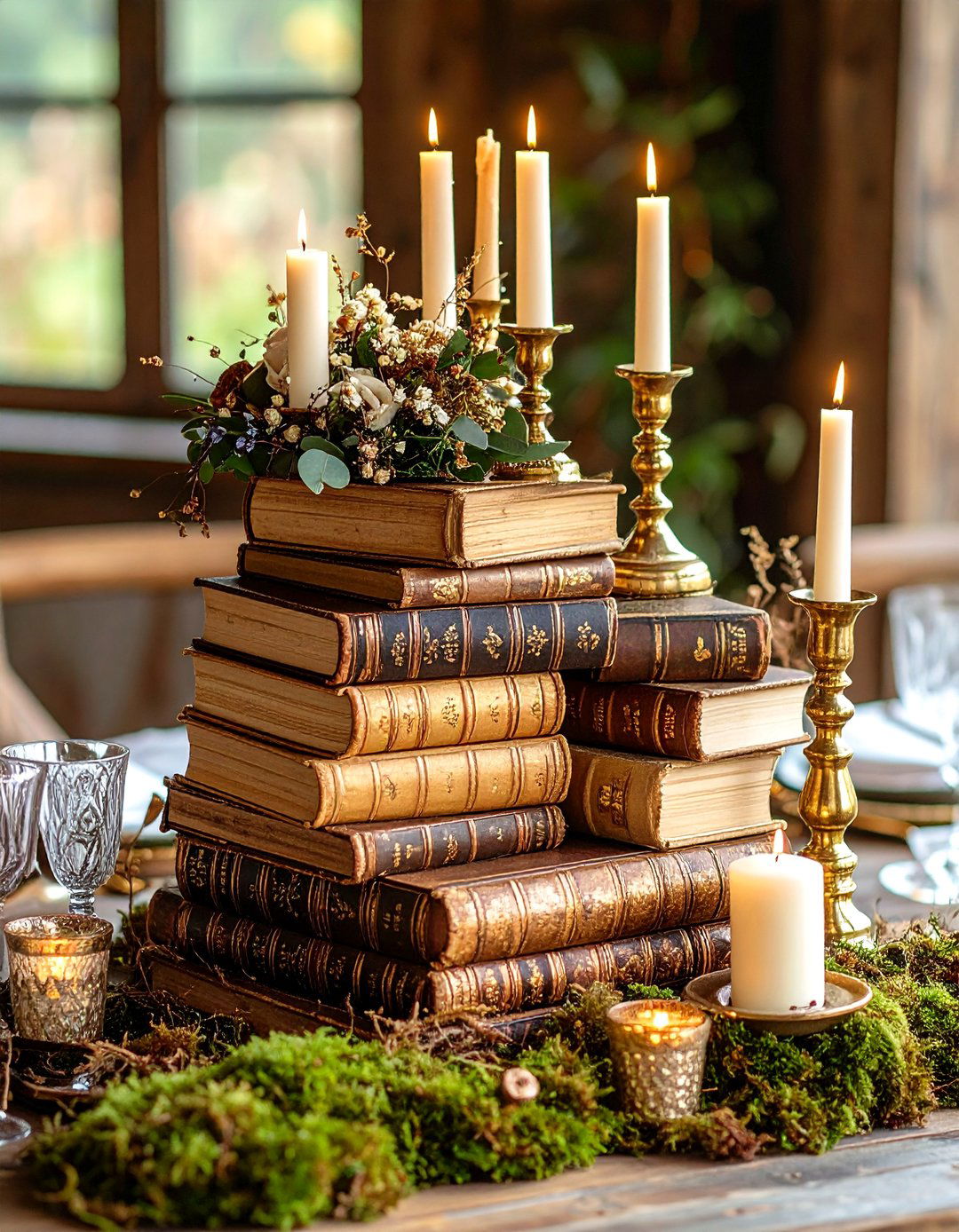
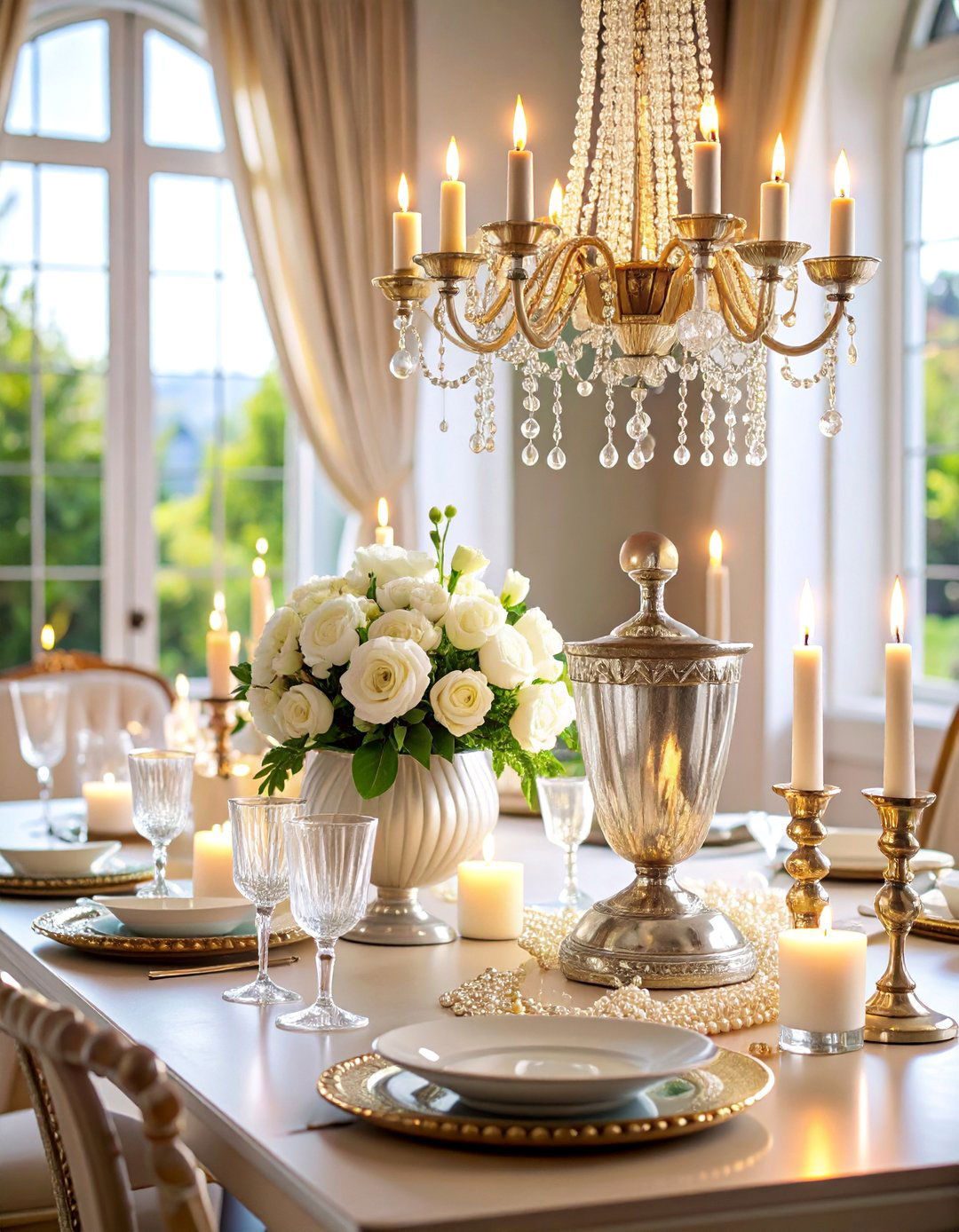
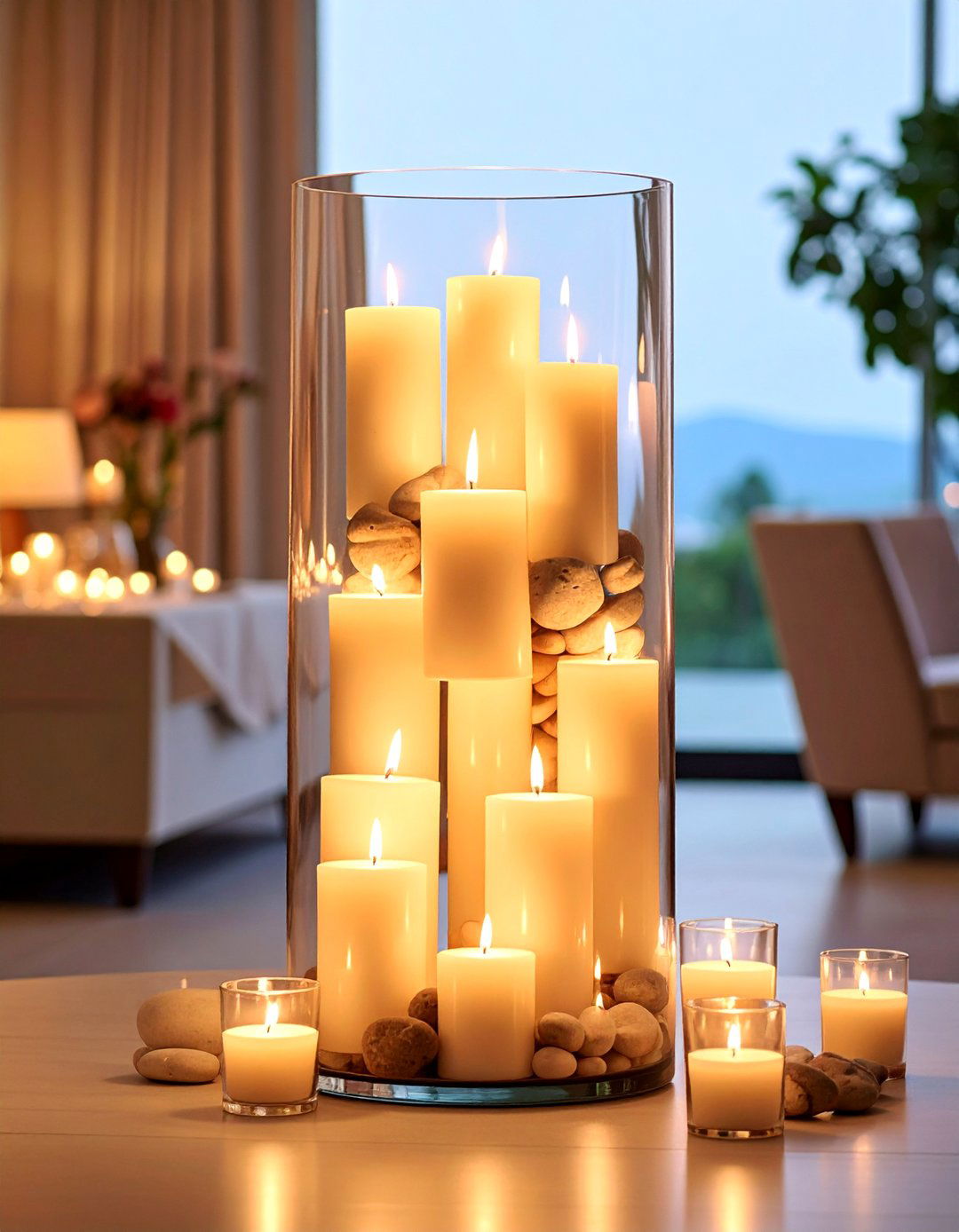
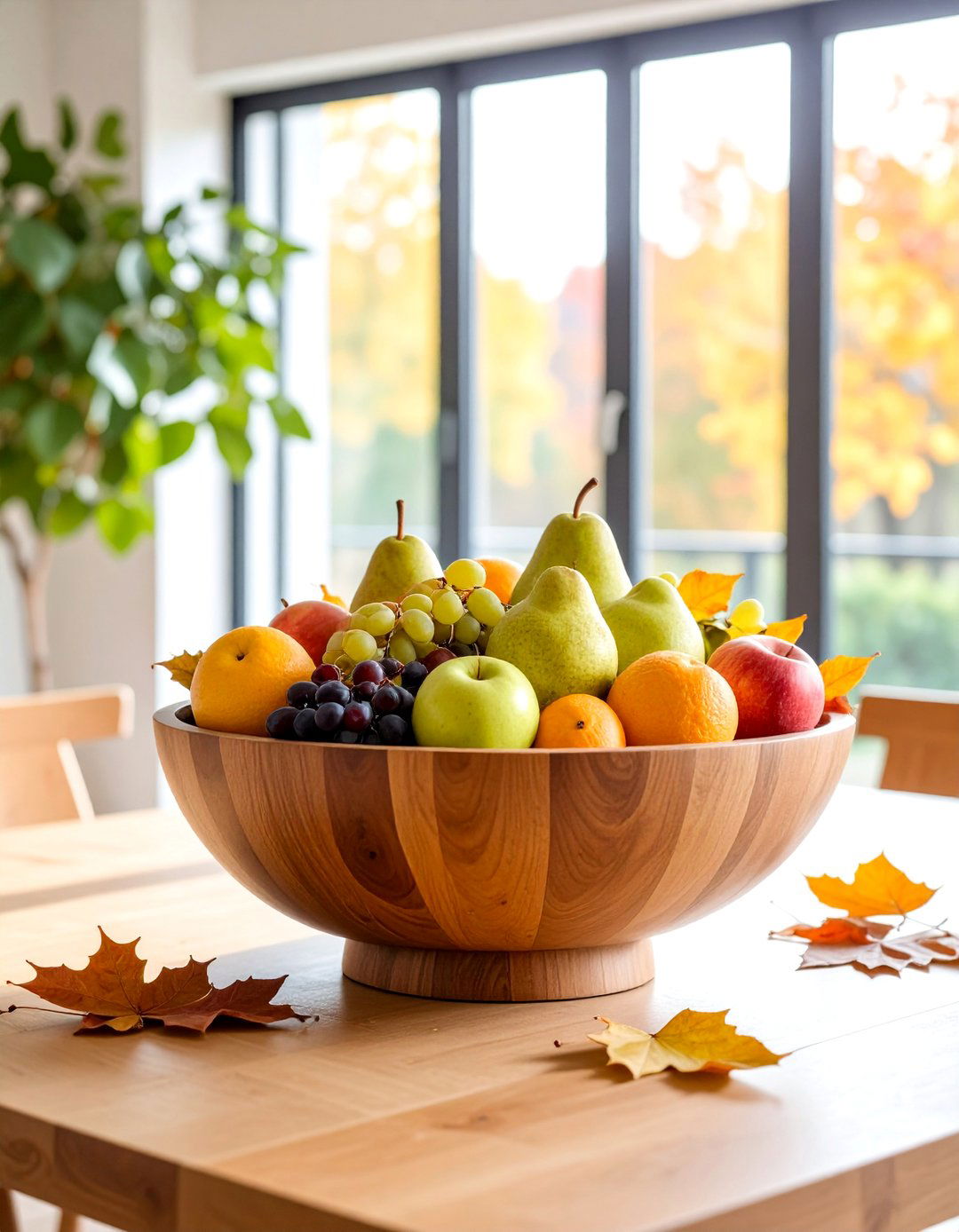
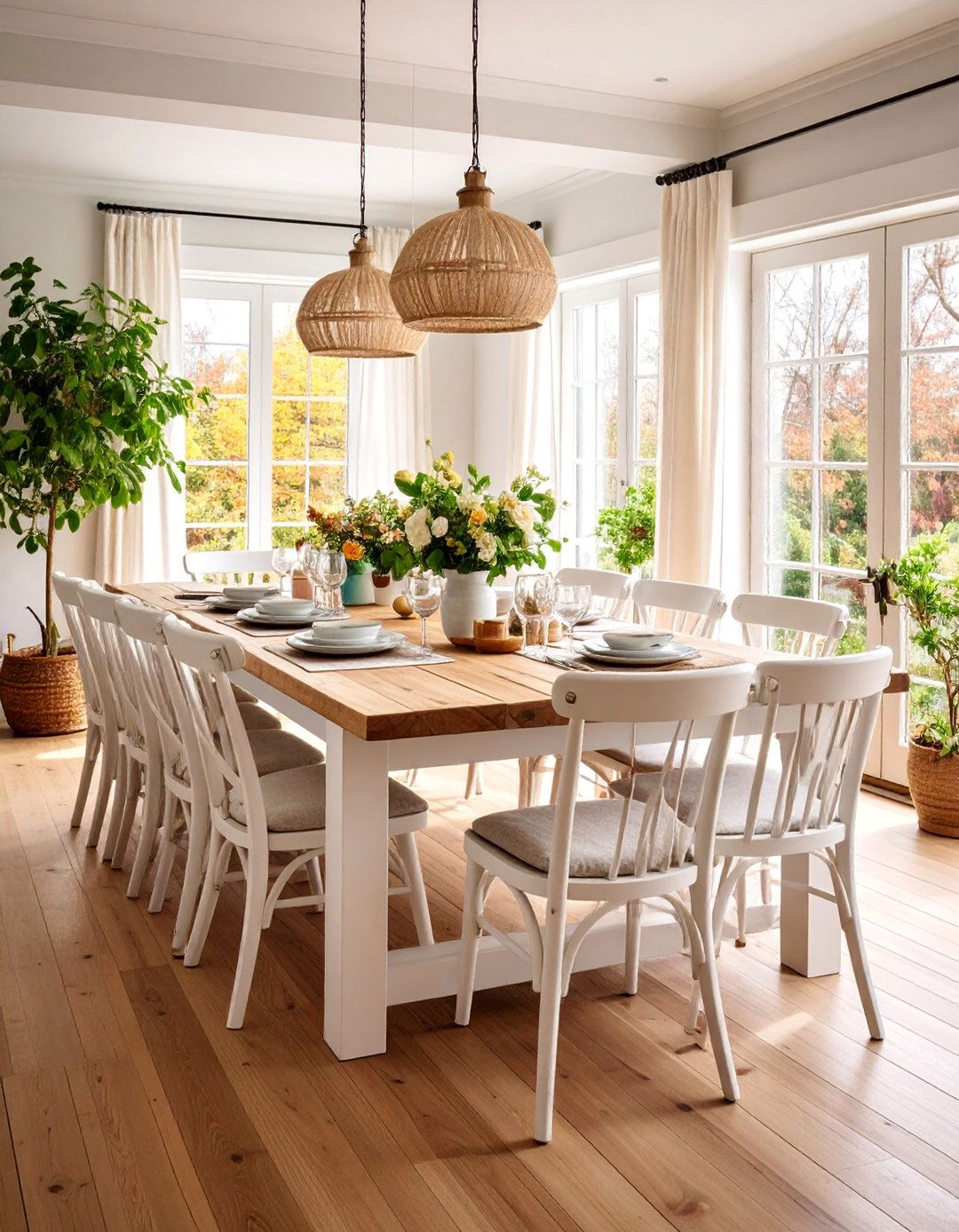
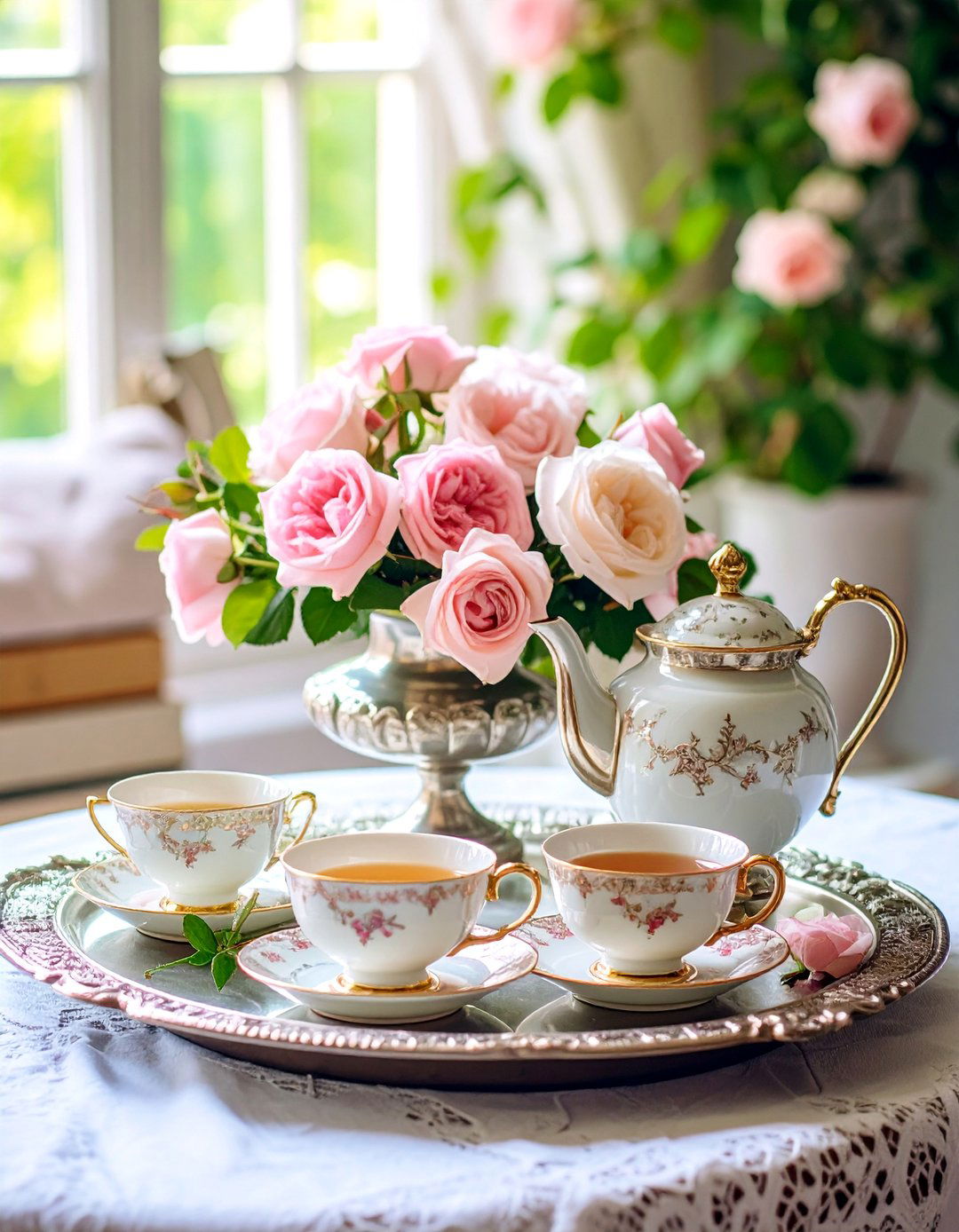

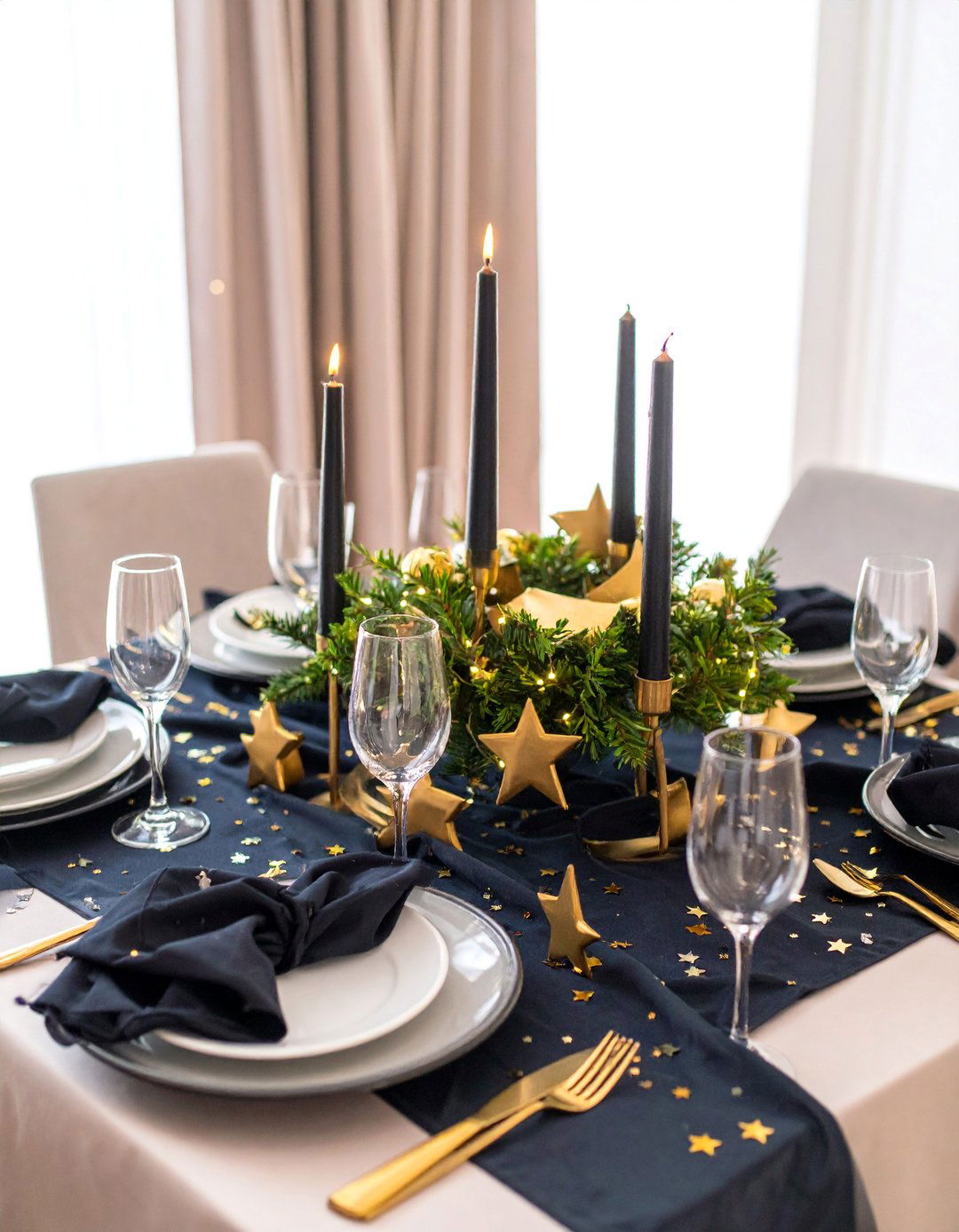
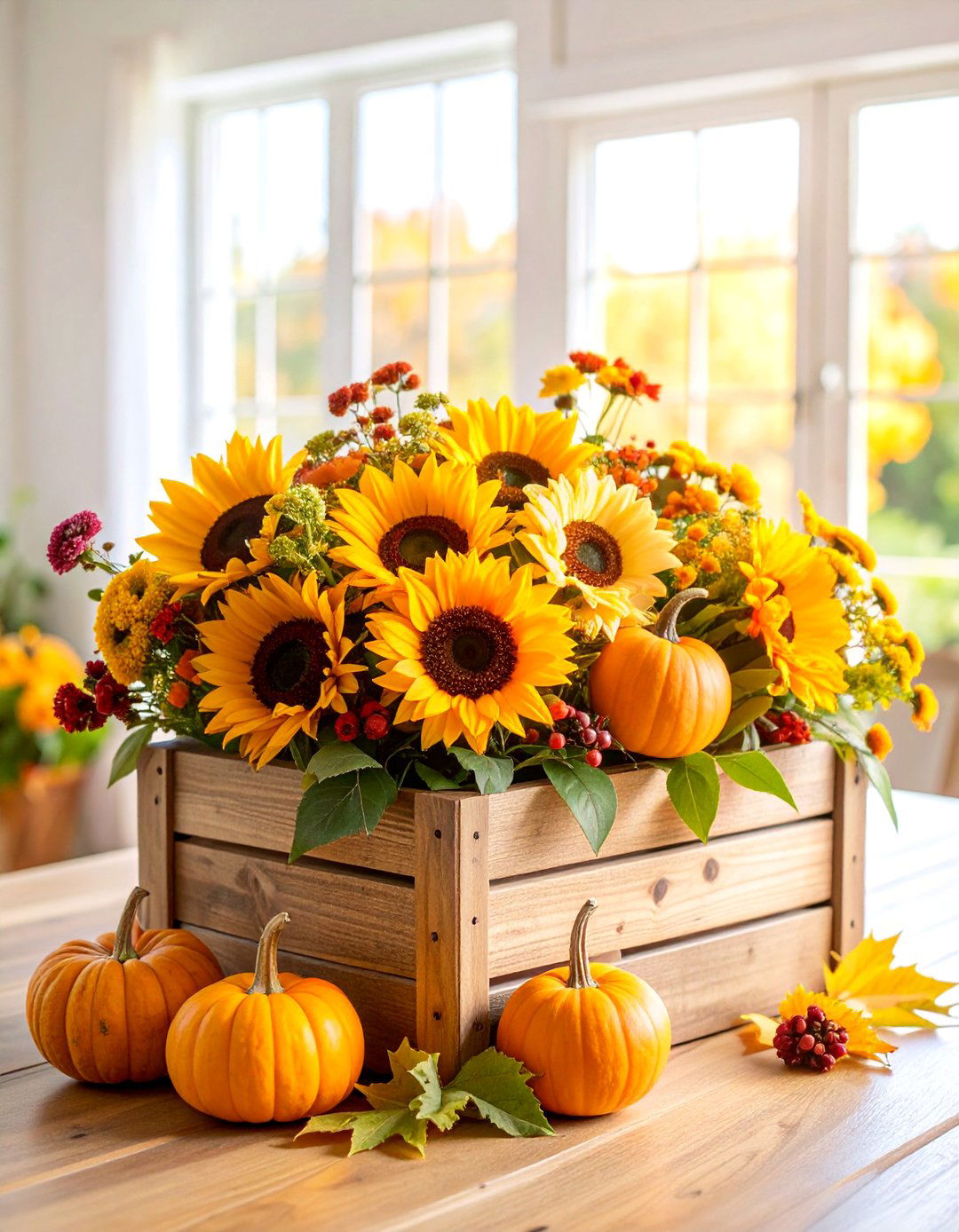
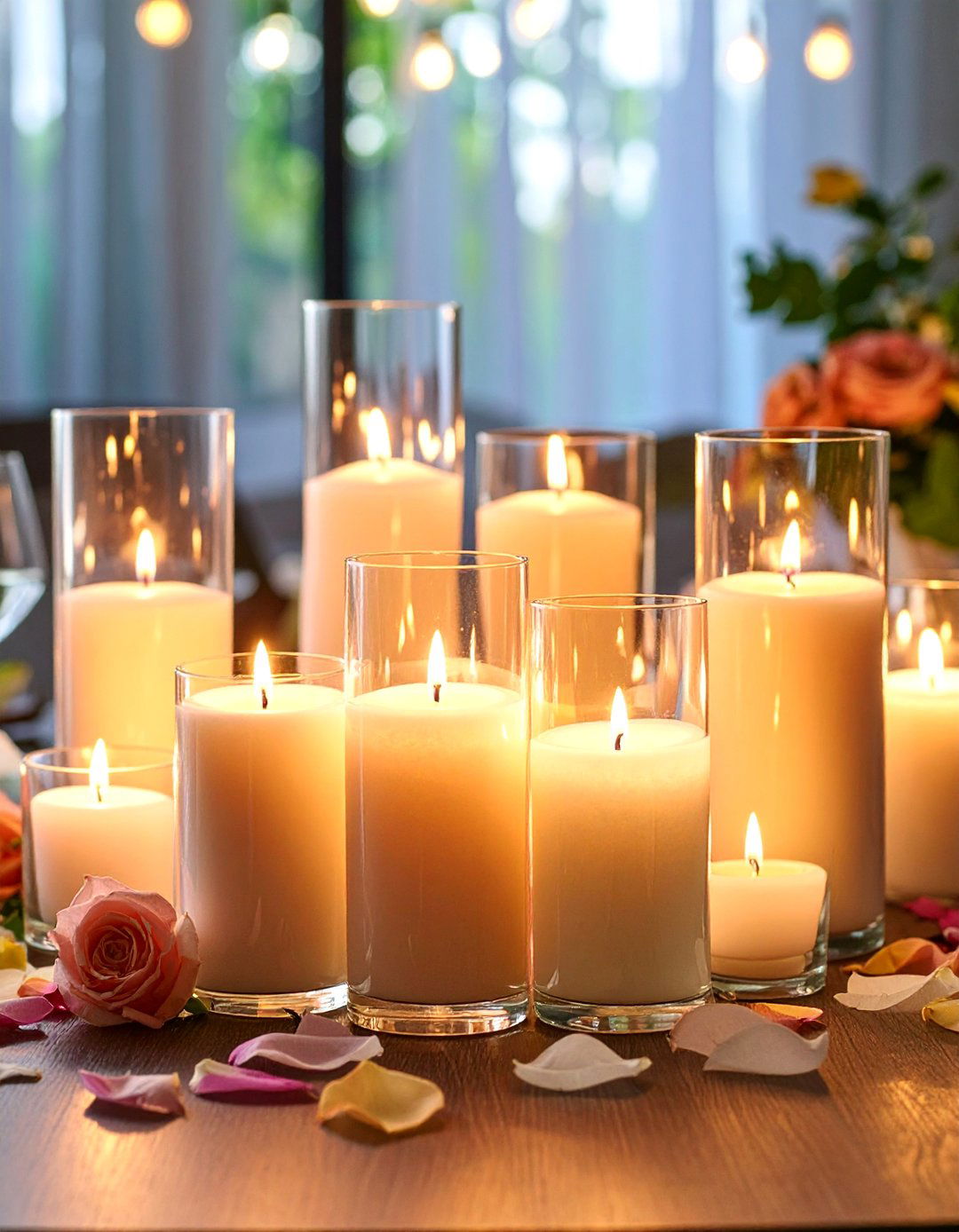




Leave a Reply